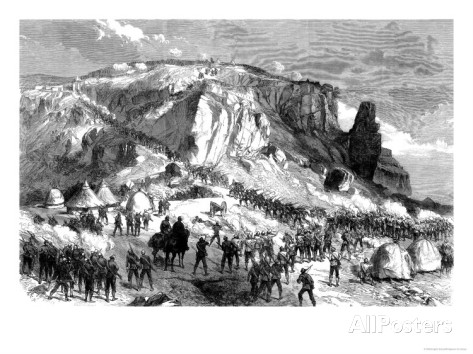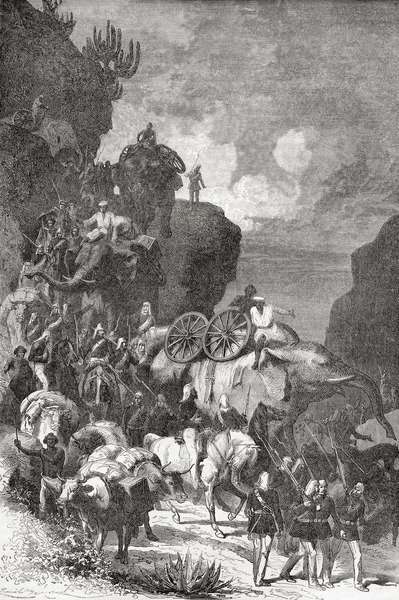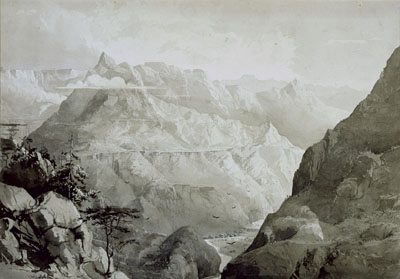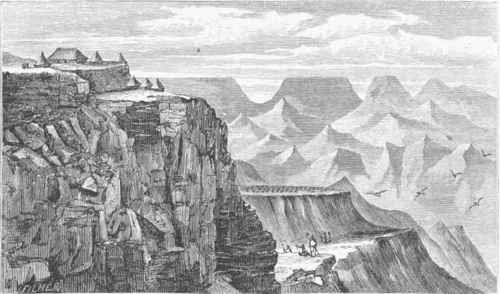Epic British Invasion of Abyssinia, 1868

I am rereading one of my favourite chapters from Alan Moorehead’s the Blue Nile, his second book about the opening up of Africa to European explorers in the 18th and 19th centuries. The final part is the epic, reluctant British invasion of Abyssinia in 1868. (Abyssinia corresponds to modern-day Ethiopia). The episode makes the Alps crossings of Hannibal/Charlemagne/Bonaparte seem like an amble to the corner store.
Moorehead sets the tone well: “There has never been in modern times a colonial campaign quite like the British expedition to Ethiopia in 1868. It proceeds from first to last with the decorum and heavy inevitability of a Victorian state banquet, complete with ponderous speeches at the end. And yet it was a fearsome undertaking; for hundreds of years the country had never been invaded, and the savage nature of the terrain alone was enough to promote failure.”
The background (very briskly): paranoid, megalomaniacal Abyssinian King Theodore II had, after a series of comical diplomatic misunderstandings, imprisoned the British consul and a handful of unfortunate random Europeans who happened to be standing nearby him. By all accounts, Theodore was one of the most debauched, brutal and emotionally unstable tyrants “to ever swing a sceptre.” The Europeans had languished there for almost 4 years, with Theodore alternately ignoring them, torturing them, fawning all over them, and making them listen to him rant for hours about how lazy, stupid and ungrateful his own subjects were. The British Government, after patiently trying dipolomatic channels, reluctantly decided that military force was necessary to rescue them. And, in typical British fashion, they decided that if the job was worth doing it was worth doing properly.
First, marvel at what they brought with them:
[F]orty-four trained elephants were sent from India to carry the heavy guns on the march… A railway, complete with locomotives and some twenty miles of track, was to be laid across the coastal plain, and at the landing place large piers, lighthouses and warehouses were to be established. … a telegraph line several hundred miles in length… three hospital ships were to be equipped with Keith’s ice-making machines, and among their stock of medicines were 250 dozen bottles of port wine for each vessel. Then there was the question of the Maria Theresa dollars, the only general currency in Ethiopia. Not any dollar would do; only the 1780 mintin that Baker described as showing ‘a profusion of bust’ in the empress’s image was acceptable, and a search of the banks and money-lenders in Marseilles, Cairo and Vienna revealed that not enough were available. A contract therefore had to be signed with the imperial mint in Vienna for a new issue of 500,000. … From Calcutta and Bombay, from Liverpool and London, sailing ships and paddle-steamers, vessels that were a combination of steam and sail, converged upon the Red Sea at their appointed teams. Half a million pounds was spent in hiring these ships and they carried on board every possible contrivance to set up a new temporary civilisation in the wilderness.
I should also mention the 13,000 soldiers, 26,000 camp followers and over 40,000 animals. Don’t be mistaken: all this kit wasn’t for fighting Theodore. Theodore’s army was exactly what you might imagine an African army of the mid-19th century to be: a ragtag horde of around nine-thousand tribesmen armed only with spears. So why did the British need so much gear? To do battle with the colossal Abyssinian countryside.
They were now in a region of 9,000ft passes, and the tracks up the cliffs were so steep and narrow that if one animal stopped they all stopped… Tremendous thunderstorms swept the mountains almost every day, and the men were forced to march in sopping clothing with temperatures down to zero.

To descend for thousands of feet into one of these ravines, to wait while the sappers threw a bridge across the stream and then to climb back up to the plateau on the opposite bank - this could be the work of several days.

If that sounds epic then consider the Big Boss waiting at the end of their march. Again, the true enemy isn’t Theodore’s army: it’s the landscape. In this case, it’s King Theodore’s fortress village, Magdala.
Three flat-topped peaks, each about nine-thousand feet in height… an attempt would have to be made to climb the thousand foot cliffs of the fortress with the aid of scaling ladders - one of the most dangerous operations imaginable.

How marvelous it is to imagine the spectacle. In their comically brash uniforms they unrolled a great carpet of Britishness over mountains and through ravines and deep into Conrad’s dark heart. The engineers are laying railroads and blasting roads and sinking wells and herding elephants up steep ravines. The officers have brought their wives and dine on pheasant in their tents each night. British civilisation advances inch-by-inch into the monumental, unmapped interior of Africa[^1]. Inch-by-inch they lug their tubas and bottles of port deeper into a cruel, anarchic land of tribal warfare and marauding Arab slavers, toward a clifftop confrontation with a mad tyrant who routinely goes on weeklong drunken debauches, butchering random subjects before locking himself in a church all night to pray for forgiveness.
Then, only 5 months after the first ships arrived, they were gone. Having rescued the hostages and razed Magdala, the British methodically rolled up their carpet back to the coast, loaded everything onto boats and left. Lock and stock: they even took their railroad tracks with them.
And, yes, they really did bring a brass band.
[^1] The reader may be surprised that as late as 1875 a great deal of Africa was (to the West) still a vast blank space on the map. In particular, the source of the Nile remained one of the world’s great mysteries and had been since Herodotus first attempted to ascend the river in 460 B.C. Many explorers from many civilisations over many centuries had failed to penetrate the secret. It was through the eye-watering sufferings endured by (mostly British) explorers (Livingstone, Burton, Speke, Stanley) that the mystery was finally solved and the heart of Africa pencilled in. Their story is terrific and compellingly told in Alan Moorehead’s the White Nile (1960).